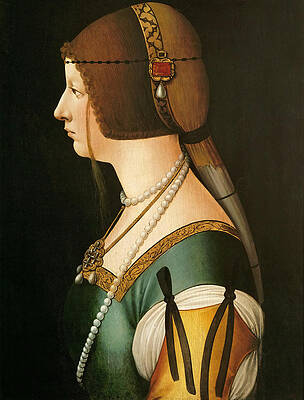Giovanni Ambrogio de Predis
Paintings
Profile Portrait of a Lady
Bianca Maria Sforza
Girl with Cherries
Workshop of Giovanni Ambrogio de Predis
Bianca Maria Sforza
Fine Art Prints | Greeting Cards | Phone Cases | Lifestyle | Face Masks | Men's , Women' Apparel | Home Decor | jigsaw puzzles | Notebooks | Tapestries | ...
Giovanni Ambrogio de Predis (c. 1455 – c. 1508) was an Italian Renaissance painter from Milan, who is known for having collaborated with Leonardo da Vinci, and with his own brother Evangelista, in the painting of the Virgin of the Rocks for the altarpiece in the chapel of the Confraternity of the Immaculate Conception at the Church of San Francesco Grande, Milan. Ambrogio, who was born in Preda, gained a reputation as a portraitist, including as a painter of miniatures, for the court of Ludovico Sforza.
A marriage was arranged between Emperor Maximilian I and Bianca Maria Sforza, niece of Ludovico il Moro, but before the former would commit to the arrangement, he requested a portrait of his proposed bride. The portrait of Bianca Maria was painted by Ambrogio, who followed her to Innsbruck after the wedding in 1493. In 1494 he returned to Milan, where he designed coins for the mint, designed and supervised tapestry works, and prepared stage scenery. In 1502 he produced his only surviving signed and dated work, a portrait of the Emperor Maximilian. Much of Ambrogio de Predis's artistic output remains in dispute. The side panels for the Virgin of the Rocks, now in the National Gallery, London were stated by the brothers to have been painted by them during the legal dispute over the altarpiece, and this is accepted by art historians.[1]
Cultural References
In Canto XLV of Ezra Pound's The Cantos, Pound denounces usury and tells what usury contradicts and what can be accomplished without it by juxtaposing historical figures of the humanist movement and the Renaissance: "Came not by usura Angelico; came not Ambrogio Praedis, came no church of cut stone signed: Adamo me fecit."
References
National Gallery Catalogues: Catalogue of the Earlier Italian Schools, Martin Davies, National Gallery Catalogues, London 1961, reprinted 1986, ISBN 0-901791-29-6
Freedberg, Sydney J. (1993). Pelican History of Art, ed. Painting in Italy, 1500-1600. Penguin Books. p. 382.ISBN 0-14-056035-1
----
Fine Art Prints | Greeting Cards | Phone Cases | Lifestyle | Face Masks | Men's , Women' Apparel | Home Decor | jigsaw puzzles | Notebooks | Tapestries | ...
----
Artist
A - B - C - D - E - F - G - H - I - J - K - L - M -
N - O - P - Q - R - S - T - U - V - W - X - Y - Z
Retrieved from "http://en.wikipedia.org/"
All text is available under the terms of the GNU Free Documentation License






